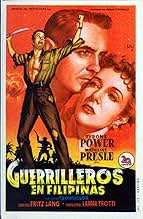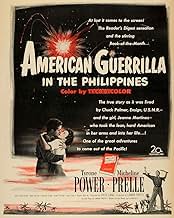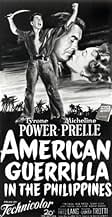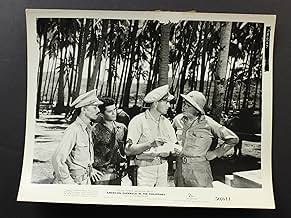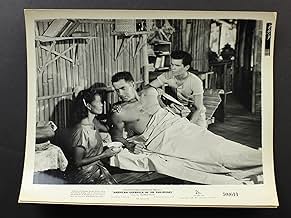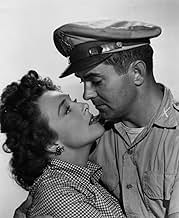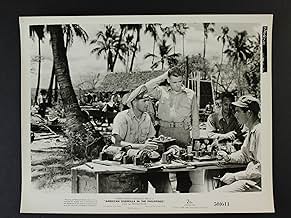I guerriglieri delle Filippine
Titolo originale: American Guerrilla in the Philippines
VALUTAZIONE IMDb
5,9/10
1422
LA TUA VALUTAZIONE
Aggiungi una trama nella tua linguaAmerican soldiers stranded in the Philippines after the Japanese invasion form guerrilla bands to fight back.American soldiers stranded in the Philippines after the Japanese invasion form guerrilla bands to fight back.American soldiers stranded in the Philippines after the Japanese invasion form guerrilla bands to fight back.
Micheline Presle
- Jeanne Martinez
- (as Micheline Prelle)
Robert Patten
- Lovejoy
- (as Bob Patten)
Miguel Anzures
- Native Traitor
- (non citato nei titoli originali)
Sabu Camacho
- Bo
- (non citato nei titoli originali)
Erlinda Cortes
- Partisan
- (non citato nei titoli originali)
Cris de Vera
- Japanese Officer
- (non citato nei titoli originali)
Rosa Del Rosario
- Partisan
- (non citato nei titoli originali)
Maria del Val
- Señora Martinez - the Aunt
- (non citato nei titoli originali)
Vic Diaz
- Japanese General
- (non citato nei titoli originali)
Arling Gonzales
- Radio Operator
- (non citato nei titoli originali)
Fred Gonzales
- Radio Operator
- (non citato nei titoli originali)
Eddie Infante
- Col. Dimalanta
- (non citato nei titoli originali)
Recensioni in evidenza
Not one to see a lot of war films, I have to say I enjoyed "American Guerilla in the Philippines," starring Tyrone Power and directed by Fritz Lang.
Power plays a real-life navy man, Chuck Parsons, who helped organize guerrilla forces in the Philippines after MacArthur promised to return.
There are some exciting and tense scenes, and also, the film is a tribute to the courage of the Filipinos. There are obvious non-actors in small roles, which is a little distracting, but I suppose this was done for the sake of realism.
Power is rugged and handsome as Parsons, and Tom Ewell gives an excellent performance as a wisecracking soldier.
Micheline Presle is the de rigeur love interest - it's Tyrone Power who's starring, after all, and their love scenes are great, as are their scenes where she subtly fights her attraction to him. Of course, I'd have caved right in.
Power did not get to meet the real Chuck Parsons until a few months after filming, when Parsons appeared, unannounced, in Power's dressing room when the actor was performing "Mr. Roberts" in London. One must assume Parsons was pleased to have been portrayed by a matinée idol.
Fritz Lang did a wonderful job of directing, but of course, this film is a far cry from Metropolis. It was a hard shoot for Power, as his wife, Linda Christian, miscarried while visiting him on location.
Despite other reviews on this page, Amrican Guerrilla is very watchable. You have to take it for what it is - propaganda to get the U. S. ready for the Korean war.
Power plays a real-life navy man, Chuck Parsons, who helped organize guerrilla forces in the Philippines after MacArthur promised to return.
There are some exciting and tense scenes, and also, the film is a tribute to the courage of the Filipinos. There are obvious non-actors in small roles, which is a little distracting, but I suppose this was done for the sake of realism.
Power is rugged and handsome as Parsons, and Tom Ewell gives an excellent performance as a wisecracking soldier.
Micheline Presle is the de rigeur love interest - it's Tyrone Power who's starring, after all, and their love scenes are great, as are their scenes where she subtly fights her attraction to him. Of course, I'd have caved right in.
Power did not get to meet the real Chuck Parsons until a few months after filming, when Parsons appeared, unannounced, in Power's dressing room when the actor was performing "Mr. Roberts" in London. One must assume Parsons was pleased to have been portrayed by a matinée idol.
Fritz Lang did a wonderful job of directing, but of course, this film is a far cry from Metropolis. It was a hard shoot for Power, as his wife, Linda Christian, miscarried while visiting him on location.
Despite other reviews on this page, Amrican Guerrilla is very watchable. You have to take it for what it is - propaganda to get the U. S. ready for the Korean war.
Had BACK TO BATAAN and BACK TO BATAAN not been made, then I assume that American GUERILLA IN THE PHILIPPINES would probably be a better remembered film. That's because it's an excellent movie in just about every way, but the earlier John Wayne and Robert Taylor films about the Philippines during WWII were very outstanding films and tend to overshadow this Tyrone Power flick.
While the plot is not identical to these other two films, there are many similarities. All three document the heroic efforts of the Philippino partisans as well as that of Americans stuck in this land during the war. About the only noticeable difference was that the Power film was in color and I really think for this subject matter, black and white actually worked better--looking more like what you'd expect a WWII film to look like. Plus, the other two films are just a little more exciting and involving--but this isn't to say this Power film is bad--it just isn't quite as involving.
Still, among the many, many WWII films, this one is a bit better than average and well worth a peek. And, yes, I also noticed the line that said a Navy Ensign is equivalent to an Army Major! I'm surprised that Power, with his WWII experience, would have said such a stupid line. An ensign is most closely equivalent to an Army Lieutennant--a much lower rank.
While the plot is not identical to these other two films, there are many similarities. All three document the heroic efforts of the Philippino partisans as well as that of Americans stuck in this land during the war. About the only noticeable difference was that the Power film was in color and I really think for this subject matter, black and white actually worked better--looking more like what you'd expect a WWII film to look like. Plus, the other two films are just a little more exciting and involving--but this isn't to say this Power film is bad--it just isn't quite as involving.
Still, among the many, many WWII films, this one is a bit better than average and well worth a peek. And, yes, I also noticed the line that said a Navy Ensign is equivalent to an Army Major! I'm surprised that Power, with his WWII experience, would have said such a stupid line. An ensign is most closely equivalent to an Army Lieutennant--a much lower rank.
9w0aq
I caught this movie on the Fox Movie Channel last week. A shame that the DVD is not available as this one would be a keeper. If you like WWII era movies this one is a good one. It documents insurgency activity against the Japanese during the war. A rag-tag group of people including some Americans separated from the rest of their detachment lead locals in a courageous and sometimes complex scheme to keep the enemy unaware of their activities.
This was an easy movie to get into and one I would add to my collection if available. It is in color as well and features some spectacular shots.
This was an easy movie to get into and one I would add to my collection if available. It is in color as well and features some spectacular shots.
It's not really about what I thought of the film - I note military and naval experts have commented on various inaccuracies. This is more a comment on an aspect of the film, which I saw many years ago in b/w, and got a greater insight into when seeing the Canadian commentator Elwy Yost's programmes on cinema history in the 1970's. How many viewers realise that the reason the heroine (the Filipino hero's wife) is cast as a Frenchwoman? This is not to make the story more romantic, or as a tribute to 'our gallant wartime allies' or even because the actress might be French, but because in those days to comply with the Hayes Code, the heroine, if she gets the white hero in the end (or vice versa!) has to be white!
There were hundreds of these cheap-ish World War Two quickies in the decade following the close of the conflict itself. They differed little from those produced during the war, still being in a kind of adulatory propagandistic mode, except that they were a little more vague usually having no direct message. What's more, as more time went by the seemed to get further and further from the realities of the conflict.
An American Guerrilla in the Philippines sees Tyrone Power, swashbuckling idol of the pre-war years, as an officer battling Japs in the Philippine jungle. Power has matured as an actor since his pictures a decade earlier, appearing tougher and less boyish, although he has also become less interesting in the process. His performance is steady and natural, but he is unable to make anything of what is admittedly a rather bland character on paper anyway. His buddy Tom Ewell is an unusual addition to the cast. He was in later years a very fine comedy actor, but it's hard to tell if he's appearing here as comic relief or not. In some moments, such as his burbling in the water trying to stay afloat, seem as if he is trying to play them for laughs, inappropriately if so, and certainly not at all funny. The rest of the cast is simply plain bad or plain boring.
Director Fritz Lang is normally someone who can give a nice baroque touch to even the most American of film formats, while still remain true to genre and tone. He seems uncertain however quite what to do with this one. He gives many shots in the jungle an abstract feel, with no familiar points of reference, giving them a threateningly wild look. Often his camera takes a spectator's position, peeping out through foliage. It's hard to tell what purpose this serves, as it distances us from the events on screen. Incidentally, Lang was a very good director of crowds and action, as evidenced in his big-budget silent pictures. There are some very powerful moments, with characters moving straight towards us down the middle of the shot and memorably stylised movements. However for a director who is normally so good at imbuing his work with a dark and nightmarish feel, An American Guerrilla in the Philippines has none of the bleak terror of, say, Operation Burma, a picture which really worked because it made us the audience feel lost within the jungle ourselves.
And ultimately An American Guerrilla in the Philippines is too light, and too sparing on any true sense of tragedy. It's lack of a real feeling of danger gives it many dull stretches, and its lack of realism does a disservice to those involved in the conflict. All of which is rather odd because the picture is also far from being a comedy. The only thing which saves it and makes it watchable is Fritz Lang's strong, vibrant imagery, such as dozens of hats waving in the air or a soldier's dying scream just inches from the lens. Having said that, there are far better Fritz Lang pictures to see these brilliant touches in.
An American Guerrilla in the Philippines sees Tyrone Power, swashbuckling idol of the pre-war years, as an officer battling Japs in the Philippine jungle. Power has matured as an actor since his pictures a decade earlier, appearing tougher and less boyish, although he has also become less interesting in the process. His performance is steady and natural, but he is unable to make anything of what is admittedly a rather bland character on paper anyway. His buddy Tom Ewell is an unusual addition to the cast. He was in later years a very fine comedy actor, but it's hard to tell if he's appearing here as comic relief or not. In some moments, such as his burbling in the water trying to stay afloat, seem as if he is trying to play them for laughs, inappropriately if so, and certainly not at all funny. The rest of the cast is simply plain bad or plain boring.
Director Fritz Lang is normally someone who can give a nice baroque touch to even the most American of film formats, while still remain true to genre and tone. He seems uncertain however quite what to do with this one. He gives many shots in the jungle an abstract feel, with no familiar points of reference, giving them a threateningly wild look. Often his camera takes a spectator's position, peeping out through foliage. It's hard to tell what purpose this serves, as it distances us from the events on screen. Incidentally, Lang was a very good director of crowds and action, as evidenced in his big-budget silent pictures. There are some very powerful moments, with characters moving straight towards us down the middle of the shot and memorably stylised movements. However for a director who is normally so good at imbuing his work with a dark and nightmarish feel, An American Guerrilla in the Philippines has none of the bleak terror of, say, Operation Burma, a picture which really worked because it made us the audience feel lost within the jungle ourselves.
And ultimately An American Guerrilla in the Philippines is too light, and too sparing on any true sense of tragedy. It's lack of a real feeling of danger gives it many dull stretches, and its lack of realism does a disservice to those involved in the conflict. All of which is rather odd because the picture is also far from being a comedy. The only thing which saves it and makes it watchable is Fritz Lang's strong, vibrant imagery, such as dozens of hats waving in the air or a soldier's dying scream just inches from the lens. Having said that, there are far better Fritz Lang pictures to see these brilliant touches in.
Lo sapevi?
- QuizThis movie was filmed just prior to the outbreak of the Korean War in June of 1950, and used American warships to portray Japanese ships. One such ship, the U.S.S. Orleck (DD 886), exists to this day after serving in the Korean War, the Vietnam War and being sold for a while to the Turkish Navy, and is permanently docked in Lake Charles, LA, where it serves as a museum.
- BlooperWhen setting the sail early in the movie, Power's character refers to a halyard as a sheet. No real sailor would make such an error.
- ConnessioniEdited into All This and World War II (1976)
I più visti
Accedi per valutare e creare un elenco di titoli salvati per ottenere consigli personalizzati
- How long is American Guerrilla in the Philippines?Powered by Alexa
Dettagli
- Data di uscita
- Paese di origine
- Lingue
- Celebre anche come
- American Guerrilla in the Philippines
- Luoghi delle riprese
- Azienda produttrice
- Vedi altri crediti dell’azienda su IMDbPro
- Tempo di esecuzione1 ora 45 minuti
- Proporzioni
- 1.37 : 1
Contribuisci a questa pagina
Suggerisci una modifica o aggiungi i contenuti mancanti

Divario superiore
By what name was I guerriglieri delle Filippine (1950) officially released in India in English?
Rispondi
